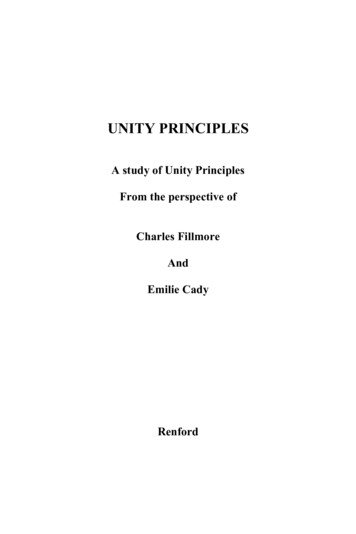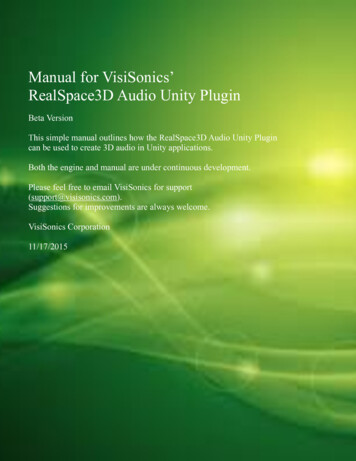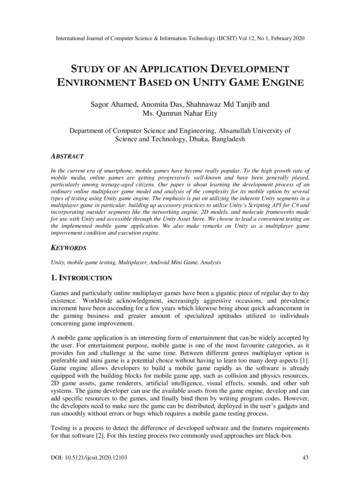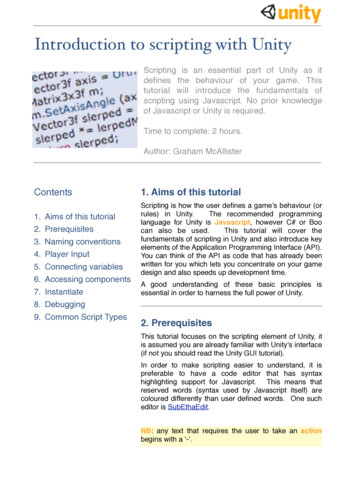
Transcription
UNITY PRINCIPLESA study of Unity PrinciplesFrom the perspective ofCharles FillmoreAndEmilie CadyRenford
Copyright 2006 by the Institute of Applied MetaphysicsAll rights reserved. No part of this book may bereproduced in any form or by any electronic or mechanicalmeans, including information storage and retrieval systemswithout permission in writing from the publisher, except bya reviewer who may quote brief passages in a review.The course of study drawn from the Renford Books isadministered by the Institute of Applied Metaphysics. TheInstitute is independent of any religious organization, newage group or philosophical society while cooperating withmany.Published byIAMPress3053 Dumbarton RoadMemphis, TN 38128ii
AcknowledgmentsThis book began with research of comments made byCharles Fillmore, Emily Cady with regard to the UniversalLaws. This is a tribute to the founders and CharlesFillmore in particular.This is the third book that has seemed to come from nointent. In other words I was not consciously thinking ofwriting the book. I hereby acknowledge the inner beingthat is the real me, the I AM Consciousness that hascontributed most to this book.After completing the first draft of the manuscript I gavecopies to Rev. Bernard Dozier, a retired Unity Minister andcurrently the interim Pastor of First Unity in CordovaTennessee, and Rev. Jim Steele, Minister of Unity ChristianChurch in Memphis Tennessee.Both reviewed themanuscript, making suggestions and giving meencouragement with the project.Contributions to the editing and proof reading have beenmade by Rev. Bernard Dozier, Revel Foren and DianePowell. All have been enthusiastic with their support of thisbook.The book cover design, formatting and preparation forpublication was under the direction of Cecil McDaniel, theMarketing Director for the Institute of AppliedMetaphysics. He also developed the online program ofdistribution.iii
The ChallengeThe two quotes shown below are from the writings ofCharles Fillmore and most succinctly state two problems heposes and answers. This is the subject matter of The UnityPrinciples. When he used the word “we”, he was not justtalking about Unity leaders but Christianity as a whole.The principles he refers to apply to all people everywhere –all the time.“We have never thought for ourselves in religion,consequently we do not know how to think accurately andconsecutively upon any proposition. We have not beentrained to draw conclusions each for himself from auniversal pivotal truth.Consequently, we are notcompetent to pass judgment upon any statement sopredicated. Our manner of deciding whether or notcertain statements are true or false is to apply the mentalbias with which heredity, religion, or social custom hasenvironed us, or else fly to some manmade record asauthority.”Charles Fillmore – Dynamics for living pg. 14In the following quote Fillmore is talking about Christianityas a whole but I believe we need to specifically apply thisto the Unity Movement. We need to think of Unity as amovement as opposed to just another Christiandenomination because the founders had a revolutionaryway of looking at the teachings of Jesus.iv
“We have not been more successful in making theteachings of Jesus a practical standard for everydayguidance because we have not understood the laws onwhich they are based. Jesus would not have put forth adoctrine that was not true and not based on unchanginglaw.”Charles Fillmore – Dynamics for living Pg 186The key phrases in these quotes, “universal pivotal truth”and “unchanging law”, refer to the Universal Laws, andthese Laws actually constitute the Unity Principles.v
ContentsIntroduction1Chapter One – The Sources7Chapter Two – Reference the Universal Laws13Chapter Three – Reference the Law of Being21Chapter Four – Reference the Law ofAbsolute Unity31Chapter Five – Reference the Law of ProperPerspective37Chapter Six – Reference the Law of PurePotentiality43Chapter Seven – Reference the Law ofBelieving and Knowing49Chapter Eight – Reference the Law ofAbundance57Chapter Nine – Reference the Law ofAttraction63Chapter Ten – Reference the Law ofRelativity67Chapter Eleven – Reference the Law ofBalance and Equalization73Chapter Twelve – Reference the Law ofEvolution and Unfoldment77vi
Chapter Thirteen – Reference the Law ofGiving85Chapter Fourteen – Reference the Law ofRighteous Self-interest91Chapter Fifteen – Reference the Law ofLove97Chapter Sixteen – Summary103Chapter Seventeen – Master Mind111vii
Oneness Conceived – Duality PerceivedIt is in the conscious mind we learn to discriminate;To carefully pull apart, analyze and to differentiate.Each race is proud to set itself above and apart,Our cultures, customs, our passions and our art.Our mind-set is to argue over what we think is better.Each thinks his traditions come from God to the letter.Individual responsibility is an indispensable prerequisite;Expressing individuality just to be different – inadequate.We spend our lives in an effort to distinguish our name.In the eyes of the world we seek approval and avoid blame.In the material world and in all forms of life we analyze;We classify, discuss at length, and in the end, categorize.We’re concerned with religious division and disharmonyBut we continue to build walls around our philosophy.We are concerned with how each is unique or different –And ignore the truth in each, the Laws invariant.The atom and the vast universe we wish to know,Have in common the same structure, the pull to and fro.Entangled and deluded by what we think is Reality,Unable to imagine the whole, we fail to see the Unity.Renfordviii
IntroductionFor more than 30 years I have been a student of theUniversal Laws. I have studied major religions specificallylooking at the teachings of the Great Masters from whichthose religions drew their inspiration. Within the first fewweeks of coming into contact with Unity in 1999, I wassatisfied that Fillmore and Cady were very much aware ofthese Laws, and that, in fact, there was no differencebetween what I called the Universal Laws and what werefer to as the Unity Principles or Truth Principles.My study of the Universal Laws began in 1966 while amissionary teacher in South Viet Nam.From thebeginning, I recognized statements of principle in theDhammapada, the Tao Teh Ching, the Kabballa and theVedas to be similar to sayings or parables of Jesus. Oncethe principles became clear to me, I began to build a matrixwhere I would slot in the statement from each tradition.It was years before I came across writers who actuallylisted and defined the Universal Laws. Then I found themeverywhere including right under my nose. This is why,when I came across Unity, the first thing I did was studythe writings of the founders. Had these writings notverified their knowledge and understanding of theUniversal Laws, I would never have continued myattendance at Unity classes and services.My understanding of the Unity Principles is based upon myin depth study of the Universal Laws and not upon anyformal training by Unity. However, I could have reachedthe same conclusions from the study of the writings of
Charles Fillmore. I am not a Minister of a Unity Church oreven a licensed teacher, but I can read. What is necessaryis the study by Unity members of the quotes from Fillmore,Cady and Turner under the heading of each Law. What Iam offering is a different perspective and a structure uponwhich identification of the core principles of Unity can beclearly seen and understood.In Unity, I saw the basis of the Universal Laws beingexpressed and sometimes named. In subsequent classeswith a licensed teacher, class members spoke of The 12Powers of Man by Charles Fillmore, but they spoke ofthese powers as if they were the Universal Laws. Fillmorespecifically stated that these twelve powers were facets ofGod innate in man. They are our Divine Birthright. Jesusdescribed them as “talents” in the parable we refer to as theparable of the talents. The 12 powers of man arespecifically part of the Universal Law of Being, one of 13Universal Laws.Fillmore says, “Inherent in the Mind of Being are twelvefundamental ideas, which in action appear as primalcreative forces. It is possible for man to ally himself withand to use these original forces, and thereby cooperatewith the creative law, but in order to do this he must detachhimself from the forces and enter into the consciousness ofthe idea lying back of them.” (The Twelve Powers, p. 52)Here he clearly differentiates between the twelve powersand the Universal Laws. The innate powers of being(twelve powers of man) are what we have to work with –our spiritual tools. We are to expand them because they areour birthright. We expand them in order to increase ourcapability to receive. They are ours to develop or bury. On2
the other hand, the creative law he refers to is anothername for the Universal Laws. We do not use the UniversalLaws, but we can come into harmony with them if weenhance our innate powers.I have come to know the Universal Laws by many names,such as the Secret Doctrine, the Divine Principles, thePerennial Philosophy and the First Philosophy. They havevariously been organized from 10 to 21 in number. Themost common number listed is 13, and the most commondesignation is “Universal Laws”.Fillmore and Cady do not list the Universal Laws the waythey list the 12 powers. Neither did Jesus, yet every timethe Master opened his mouth as recorded in the narrativegospels and the non-canonical, he was explaining orillustrating one or more of the Universal Laws. Sometimesit was more than one at a time, and sometimes it was onlyan aspect of a Universal Principle. Fillmore’s writingscontinually refer to the Universal Laws, and I maintain thatthe Unity Principles are, in fact, the Universal Laws.Fillmore mentions most of the Universal Laws by name,and in some cases, he expresses the principle over and overbut doesn’t give it a specific name. Sometimes heexpresses an aspect of a Universal Law and calls it aUniversal Law while at the same time showing it to be anaspect of a Law. He makes mention of many laws, some ofwhich one can categorize under a main principle, and othersare the primary principle. I use the term principle and lawinterchangeably.3
Over the years I have taught numerous classes and been aguest speaker at Unity Churches. Invariably, the subject ofthe Universal Laws has been a part of my lessons. Youcannot get more basic than the Divine Principles, yet thesubject matter is infinite in scope. You can learn fromunderstanding of them on an infinite basis because they areaspects of Universal Mind that can be grasped only fromour human process of identifying and verifying them in ourlife experiences.Most of my books were written before coming in contactwith Unity, but I have found new insights andconfirmations from the authors I quote in this book. WithinUnity, it is common to hear a member talk about the Unityprinciples as if they were some kind of creed formulated bythe icons of the Unity movement!When I first read Talks on Truth, Lessons in Truth and TheTwelve Powers of Man, I made note where each UniversalLaw was mentioned or expressed in some way. Myconclusion was, and still is, that one cannot differentiatebetween the Unity Principles and the Universal Laws.In some cases, not only are each of the Laws explained, butthey are also named comparable to the names I adoptedfrom my teachers and great writers on the subject. At thebeginning of each chapter I give the name that Fillmore orCady gave to the Law covered in that chapter. Onoccasion, they would write extensively about one of theLaws but not actually name it. Jesus spoke, illustrated orexplained each law or principle without ever naming one.For me, categorizing and classifying them has been a toolfor clarification. Listing them the way I do has helped in4
understanding of the total (Law of Creation). I recognizeall 13 laws as part of this one great principle, and so didFillmore.Many thinkers, such as Aristotle, Spinoza, Aldous Huxley,Charles Hannel and more recently Dan Millman, OgMandino, Maharishi Mahesh Yogi and Deepak Choprahave listed these principles in their books. Fillmore makeseach of the 13 Laws clear and essentially states them as Ihave, but most members may not have made the connectionbetween the Universal Laws and Unity principles.I use quotes from the founders of the Unity movementbecause Unity Principles was written primarily for Unitymembers. It is also suitable for those interested in themovement. It is a book of referenced quotes in the mainbody of each chapter under the heading of a Universal Law.Normal quotes within a paragraph may or may not containthe reference.The purpose of this book is to provide evidence in thewords of Charles Fillmore, Emily Cady and Elizabeth SandTurner as to the Unity Principles upon which the movementwas based. I have commented sparingly on these quotesexcept in the introduction of each chapter and the summary.I have noted in bold letters significant words and phraseswith regard to a Universal Law. Judge for yourself fromthese quotes what the Unity principles are.5
6
Chapter OneThe SourcesFrom the Day of Pentecost depicted in the second chapterof the book of Acts, there has been a battle between theliteralists and the metaphysicians. It became the strugglefor the heart and soul of the church known as the orthodox(literalists) and the Gnostics (experientialists). It continuedfor 1500 years until the Church and Christianized worldwere dominated by literalists. It culminated in what isknown as the dark ages and present day dualism. Today wesee this as a battle between the fundamentalists and themetaphysicians.The words Gnostic and Gnosticism come from the Greekword gnosis usually translated as knowledge. The Greeklanguage, however, makes a distinction between theoreticalknowledge and experiential knowledge. It should beunderstood as “insight” or intuitive understanding. Gnosticgospels and ideas were unabashedly presented as myths,which is the way they interpreted all the gospels includingthe narrative gospels.Gnosticism recognizes faith (pistis) as inseparable fromknowledge. What use is the knowledge without the faith todo something with it? Gnosticism is a tradition thatreoccurs where the individual is in contemplation of theJesus mysteries. Such experience seldom, if ever, lendsitself to uniform, dogmatic formulations as found inorthodox or literalist theology. The orthodox or literalistviews elevate faith over knowledge. It was this orthodox,dogmatic, doctrinaire and closed approach to the teachings7
of Jesus and the theocracy of Christian Rome that led to thedark ages. It was the attempt to set spirit in stone thatturned out the light!Scholars say that during Christianity’s first 300 years therewere more different kinds of Christians than today. It wasthis diversity that drove Emperor Constantine to takemeasures to codify and restructure the Church to suit hisends and purposes. Christianity was to be used in hisunification of the empire. He had defeated two otheremperors in the military phase and now must have aunifying theology. He established the councils to aid in hisobjectives, but as time went on, he had little tolerance forreligious debate.Michael Grant, in his book Constantine The Great, p. 162,notes “Constantine wanted an established church, to whichall good Christians would belong; and those who would notbelong to it were dismissed as ‘heretics’ – a termresounding with mutual Christian accusations, and with along and ominous history ahead of it.Constantinedeplored this ridiculous proliferation of dissension,believing that imperial unity required unity of creeds.”Only the priests of the literalist camp were invited to theNicene Council. Constantine controlled the agenda! Whenhis guests acquiesced in what he wanted, he acquiesced inwhat they wanted, and we might say an unholy alliance wasformed. This gave him a unifying force for his empire andallowed the leaders of this newly empowered church topersecute all manner of religions from which they werealready borrowing heavily.8
There has been a resurrection of interest that modern dayGnostics claim dating from publication of the Dead SeaScrolls and the Nag Hamadi Scrolls. In fact, metaphysicsexisted long before Christianity in the teachings of HermesTrismegistus. During Jesus’ lifetime, the Jewish masterPhilo taught metaphysics. Metaphysicians never quitedisappeared even during the period of literalists’domination and the “dark ages”. In the 1600s, Spinozaillustrates understanding of the Universal Laws. He wrote,“There is no need that we should understand the series ofindividual mutable things, for their essence is only to befound in fixed and eternal things, and from the lawsinscribed in those things as their true codes, according towhich all individual things are made and arranged; nay,these individual and mutable things depend so intimatelyand essentially on these fixed ones that without them theycan neither exist nor be conceived.”In the past 100 plus years many groups have developedunder the somewhat confusing label of “New Age”. Thereis nothing new in “New Age”. In fact, it is very old,however, there is as much superstition and nonsense insome New Age writings as there is in fundamentalistliteralist dogma. There is a big difference between what ispublished under the label of “New Age” or “New Thought”and the metaphysics of Charles Fillmore and Emily Cady.“New Age” has become a catch all for many paganteachings and much cultural superstition. It is a minglingof Eastern traditions and Western mysticism and more.Fillmore walked his own line by identifying, verifying andadhering to the Universal Laws.9
Today there are those who feel that Unity is in danger oflosing touch with its metaphysical heritage and that it mustgo back to the basics or end up on history’s heap of failedorganizations. One retired Unity Minister, Rev. BernardDozier, says, “We need to get back to basics Unity basics.Go down to the roots. Reorient ourselves. Get stabilizedon, and in, Truth fundamentals.” This book is about the“truth fundamentals” as revealed primarily in the words ofCharles Fillmore and Emily Cady. There are also a fewquotes from Elizabeth Sand Turner and Cora Fillmore.However, none of these writers invented the UnityPrinciples. They simply taught the Universal Laws andhow to come into harmony with them.Jesus did not invent the Laws or teach totally newprinciples. They were new to the ones he taught, but asFillmore says, “He demonstrated them.” The Laws havebeen in place from before there could be the first clod ofearth (matter) as stated in Proverbs 8:22. This passagedescribes a time before that described in Genesis, Chapter1. “The Lord begot me, the first-born of his ways, theforerunner of his prodigies of long ago: From of old I waspoured forth, at the first, before the earth. When there wereno depths I was brought forth, when there were nofountains or springs of water; Before the mountains weresettled into place, before the hills, I was brought forth;While as yet the earth and the fields were not made. Northe first clods of the world. When he established theheavens I was there, when he marked out the vault over theface of the deep; When he made firm the skies above, whenhe fixed fast the foundations of the earth; When he set forthe sea its limit, so that the waters should not transgress hiscommand; Then was I beside him as his craftsman, and I10
was his delight day by day, playing before him all the whileplaying on the surface of his earth; and I found delight inthe sons of men.”In reference to the scripture above, what was poured forthand used as his craftsman were the principles upon whichthe foundations of all disciplines and even physical laws arebased. Human beings are the instrument of the continuingprocess of creation and his delight in the continuing processof creation. In the first chapter of John’s gospel is reflectedthe same thought found in Proverbs 8:22. John 1:1-3reads, “In the beginning was the Word and the Word waswith God, and the Word was God. He was in the beginningwith God, All things came to be through him, and withouthim nothing came to be.” Fillmore acknowledged thiswhen he wrote, “The first-born of everything in theuniverse is an idea in Divine Mind. In God Mind an idea isthe eternal word of Logos, the original primary, orunlimited thought of Being.” Dynamics for Living, p. 35In Egypt, possibly before the time of Abraham, Hermes orsecret mystery groups writing under that name taught whatis called the Hermetic Principles. They were more likeaxioms and can be found in all the statements of principlewe call Universal Laws. Some understanding of theUniversal Laws has been known wherever and wheneverhuman beings focused their thinking on Universal Mind.Jesus proved to be a self-realized manifestation ofUniversal Mind so there should be no surprise that in hisparables and statements are found illustrations andexplanations of the Universal Laws.11
The Fillmores and Cady, whose writings influenced Unityfrom the earliest days of the movement, focused onUniversal Principles they had identified and verified forthemselves. It was not the Fillmores’ intention to create achurch or denomination. Charles Fillmore wanted todemonstrate practical Christianity, and he wanted hisreaders and students to do the same. Making the Unityteaching consistent with Universal Principle required theFillmores to abandon fear based and dualistic concepts.There was essentially no difference in the thinking of theFillmores and other great thinkers and writers who havestruggled against the debilitating effects of fear baseddualistic concepts.Charles Fillmore, while repudiating fear based and dualisticconcepts, never divorced himself, or Unity, from essenceChristianity, saying “Unity believes in all the doctrines ofChristianity, spiritually interpreted.” The question then iswhat is “essence Christianity”, and what is correct spiritualinterpretation? I propose to show in this book that theessence of Jesus’ teachings was the Universal Laws andthat Charles Fillmore and Emily Cady identified them assuch and verified them experientially. They recognizedthat physical health, mental health and spiritual healthdepended upon moving from fear based feeling to lovebased living. The quotes drawn from his writings and thoseof Cady and Turner, show they were continually followingthis process.12
Chapter TwoReference the Universal LawsFillmore and Cady refer to the Universal Laws as“unchangeable truths”, “divine principles” and“universal laws” as well as “spiritual truths” and“immutable laws”.These Universal Principles apply to anything andeverything. In this book, I am primarily concerned withshowing that the founders of the Unity Movementrecognized these Laws and saw them as unchangeabletruths that were present in everything we can know. ThesePrinciples, being aspects of God, are omnipresent. Like thephysical law of gravity, they are ever present. It is not amatter of learning the Laws as in memorizing a creed orthe Ten Commandments. It is a matter of living them.Since they apply to everything and everyone, theirapplication goes to physical life and relative understandingas well as the greater work of unfoldment.When it comes to the Universal Laws, everyone, regardlessof his degree of understanding, can grasp the essentialmeaning of these universal rules for living. We have to livethem or experience them to know them. No matter at whatlevel we grasp them, they are true and unchangeable. Notethe following definitions of the Universal Laws:“What are usually called the promises of God are certaineternal, unchangeable truths that are true whether theyare found in the Bible or in the almanac. They areunvarying statements of truth that cannot be altered.”Cady, Lessons in Truth, p. 6613
“When he cooperates with divine principle, man sits on thethrone of his authority and the elemental force is subject tohim.” Fillmore, The Twelve Powers, p. 68“They are in the world as omnipresent Principle, havingan abiding place everywhere, because they are asubiquitous as the air. No man lives a moment withoutthem, yet few men recognize them.” Fillmore, Talks onTruth, p. 69“For if God is Spirit, the principle of intelligence and life,everywhere present at all times, He must be just asaccessible as a principle of mathematics and fully as freefrom formalism. When a mathematician finds that hisanswers to a problem is not correct, he consults theprinciple and works out the correct solution. Fillmore,Talks on Truth, p. 11“But principles do not change; man makes his heaven orhis hell, just as he did two thousand or two million yearsago.” Fillmore, Talks on Truth, p. 17“Jesus demonstrated the law of God, and His word waswith power. He became the Word of God incarnate,because He fulfilled all the requirements of the law.”Fillmore, Talks on Truth, p. 43. He is not talking aboutonly fulfillment of the law of Moses but the fact that hecame into harmony with the universal laws.“But to be or not to be rests upon the immutable law of theWord of God, for only by the light that it sheds can man seeand appropriate the privileges that are his by originalbirth.” Fillmore, Talks on Truth, p. 7414
“God never performs miracles, if by miracle is meant adeparture from universal law. Whatever the prophets didwas done by the operation of laws inherent in Being andopen to the discovery of every man.” Fillmore, Talks onTruth, p. 111“God’s Spirit goes forth in mighty streams of life, love,substance and intelligence. Each of these attributes isconscious only of the principle involved in it and in thework that it has to do. Though it is man’s mission tocombine these inexhaustible potentialities under divine law,man is free to do as he wills. But the divine law cannot bebroken, and it holds man responsible for the result of hislabors.” Fillmore, The Twelve Powers, p. 131“In working out our problems of everyday life, we shouldfirst take into consideration the relation that the problembears to God, then to our fellowmen and ourselves. Next,we should lay hold of the ideas that are to be worked uponby divine law.As these fundamental ideas areincorporated into consciousness, they make contact withthought forces on various planes of action, and the manycomplex problems that arise in the course of the soul’sevolution are harmonized under the higher law.” Fillmore,The Twelve Powers, p. 268“In some way, which it is not easy to put into words – forspiritual laws cannot always be compassed in words, andyet they are none the less infallible, immutable laws thatwork with precision and certainty.” – Cady, Lessons inTruth, p. 5215
“God’s law governs the universe and the life of allcreatures.We cannot disregard it with impunity.Persistence in spiritual discipline should be ourwatchword, and Christ has given us the capacity andstrength to move steadily forward.” Turner, Be YeTransformed, p. 153“God as the underlying substance of all things, God asprinciple, is unchanging, and does remain foreveruncognizant of and unmoved by the changing things of timeand sense.” Cady, Lessons in Truth, p. 137“In every age preceding this the priesthood has laboredunder the delusion that the common people could notunderstand the real meaning of life and that they shouldtherefore be kept in ignorance of its inner sources; also thatthe masses could not be trusted with sacred truths, thatimparting such truths to them was like casting pearls beforeswine. But now science is delving into hidden things, and itis found that they all arise in and are sustained byuniversal principles that are open to all men who seek toknow and apply them.” Fillmore, Atomic-Smashing Powerof Mind, p. 84“So long as religion assumes that the Spirit that createsand sustains man and the universe can be cajoled and byprayer or some other appeal can be induced to change itslaws, it cannot hope to be recognized by those who knowthat unchangeable law rules everywhere and ineverything.” Fillmore, Atomic-Smashing Power of Mind,p. 86“Jesus evidently understood this higher astronomy and Heknew that His work as a teacher and demonstrator of16
spiritual law was related to it, yet not controlled by it. Heco-operated with the “law and the prophets.” As far asthey went, but He knew the higher law of the Christ manand affirmed His supremacy in the words: “All authorityhath been given unto me in heaven and on earth.”Fillmore, Atomic-Smashing Power of Mind, p. 162“The true concept of God is that He is the IntelligentPrinciple of the universe, and, like all principles, totallyimpartial in His expressions.” Fillmore, Dynamics forLiving, p. 17“It is the science of life. Upon its understanding hinges thehappiness or unhappiness of man’s existence. It is not ascience whose laws were discovered and arbitrarilyclassified by those metaphysicians of the past. On thecontrary, it is universal in its unfoldment andapplication.” Fillmore, Dynamics for Living, p. 21“This system of metaphysics is but another name foruniversal Truths.” Fillmore, Dynamics for Living, p. 22“Divine Principle is fundamental Truth. God as Principleis the unchangeable life, love, intelligence, and substanceof Being.” Fillmore, Dynamics for Living, p. 30“God as law is Principle in action. Everything has itsfoundation in a rule of action, a law. Divine law is theorderly working out of the principles of Being.” Fillmore,Dynamics for Living, p. 31“By the term Mind, we mean God – the universalPrinciple, which includes all principles. In our talk about17
Mind we are forced to leave the plane of things formed andenter the realm of pure knowing.” Fillmore, Dynamics forLiving, p. 32“The absolute Truth is that which accords with God asdivine Principle; that which is, has been, and ever will be;that which eternally is. The Truth of God is reality.
name for the Universal Laws. We do not use the Universal Laws, but we can come into harmony with them if we enhance our innate powers. I have come to know the Universal Laws by many names, such as the Secret Doctrine, the Divine Principles, the Perennial Philosophy and the First Philosophy. They have variously been organized from 10 to 21 in .











